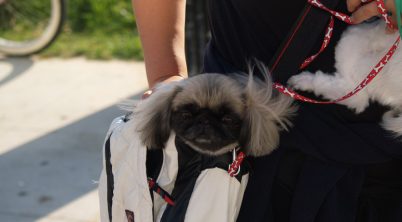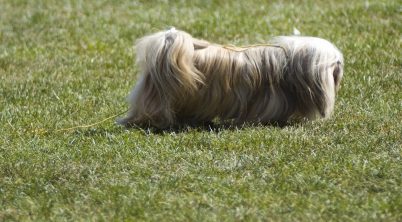The Pekingese is a dog breed with ancient origins in China, where it was favored by royalty. Characterized by its distinctive lion-like mane, short snout, and large eyes, this toy dog breed is easily recognizable. Pekingese are known for their confidence and dignity, often described as having a regal demeanor. Despite their small size, they can be quite expressive, particularly when it comes to vocalizations such as barking and howling.
Howling is a form of communication that dogs use, and the Pekingese is no exception. While they are not notoriously known as habitual howlers like some other breeds, Pekingese may occasionally howl in response to certain stimuli. This behavior can be triggered by sounds such as sirens, music, or the howling of other dogs. When a Pekingese howls, it is engaging in an instinctive practice, harking back to its ancestors’ need to communicate over distances or to signal their presence.
Understanding the howling habits of a Pekingese can help owners better cater to their pet’s emotional and communicative needs. Recognizing the triggers and meanings behind such vocalization is important for ensuring the well-being of these dogs. The Pekingese may howl for attention, to alert their owner to something, or as a response to environmental sounds. This behavior is just one part of the unique character and charm of the Pekingese breed.
Table of Contents
Pekingese Howling
The Pekingese breed, with its storied origin from ancient China, exhibits a distinctive vocal behavior known as howling. This behavior can be observed in various situations and may be sparked by different stimuli.
Why They Howl: Pekingese often howl to communicate. They might howl in response to certain sounds, such as sirens or musical instruments, or to express a desire for attention. It serves as a means to express themselves, whether it is due to excitement, anxiety, or the mere presence of their owners.
Howling vs. Barking:
- Howling: Typically a sustained, drawn-out sound; may indicate loneliness or the desire to connect with others.
- Barking: Often a more abrupt noise; used as an alert to convey excitement, deter intruders, or as a call to action.
Training and Management: Pekingese owners can manage their pet’s howling through consistent training and ensuring their companions are not left alone for extended periods. Positive reinforcement, like treats and praise, when they are quiet can discourage excessive vocalizations.
- Socialization: Introducing Pekingese to various environments and sounds can reduce anxiety-related howling.
- Exercise: Regular physical activity can help release pent-up energy and minimize howling out of boredom.
Sounds That Trigger Howling:
- Sirens
- Musical instruments
- High-pitched noises
Understanding these triggers allows owners to anticipate and manage their Pekingese’s howling behavior effectively. While some Pekingese may howl frequently, it does not necessarily indicate a problem unless it becomes excessive, disrupting the household or causing distress to the dog.
Communication and Behavior
In understanding the Pekingese breed, observing their vocal behaviors such as howling and barking provides insight into their emotional states and communicative efforts. These sounds can reflect a range of emotions from joy to discomfort and facilitate their interactions with both dogs and humans.
Understanding Pekingese Howling
The Pekingese may use howling as a form of long-distance communication, influenced by their genetic lineage linked to wolves. While not every Pekingese will howl frequently, when they do, it might be an attempt to signal their presence to other dogs, express discomfort, or desire for attention. It’s a behavior that serves multiple purposes, such as:
- Emotional Expression: Communicating feelings like loneliness or distress.
- Social Calling: Reaching out to potential pack members or family.
Barking and Noise Levels
Pekingese are known for a distinctive bark which can vary in volume and intensity. Their barking serves immediate communicative needs and can indicate:
- Alert: To signal unknown presence or potential danger.
- Excitement: Expressing joy or eagerness in social scenarios.
Barking levels often relate to the dog’s environment and how they are raised. Consistent training and calm households typically lead to more controlled noise levels.
Socialization with Dogs and People
Socialization is crucial for a Pekingese to develop a friendly demeanor towards humans and fellow canines. Positive early experiences with various people and dogs foster:
- Behavioral Development: Developing social cues and appropriate responses.
- Temperament: Building a temperament that is less prone to anger or fear-related aggression.
Effective socialization also helps mitigate excessive barking or howling, which can be signs of a Pekingese seeking social interaction or expressing anxiety.
Health and Care
The Pekingese breed, with its distinctive appearance and regal origin, demands attentive care to maintain optimal health. Their long, luxurious coat necessitates regular grooming to prevent mats and tangles. At least a weekly brush is advisable, and during shedding seasons, more frequent grooming might be needed.
Pekingese dogs have a propensity for weight gain. To mitigate obesity risks, monitoring their diet and providing measured portions is crucial. Their exercise needs are moderate; however, due to their small size, indoor play can often suffice. They still benefit from daily walks to support their health and prevent weight issues.
This breed is classified as brachycephalic, meaning they have a short nose and flat face. This trait adds a layer of complexity to their health care as it can lead to breathing difficulties. Owners should watch for symptoms of brachycephalic syndrome and avoid strenuous exercise, especially in hot weather.
As for their coat maintenance, a high-quality diet plays a vital role in maintaining the Pekingese’s coat health. Along with grooming, ensuring they have a balanced diet can help keep their fur in prime condition.
In terms of health concerns, the Pekingese may develop allergies and infections due to their dense coat and facial structure. Regular ear and eye cleaning are important preventive measures.
Lastly, always consult a veterinarian regarding medication and specific exercise regimens tailored to your Pekingese’s health status. Maintaining a proactive approach to their health and care needs can help manage potential health-related issues effectively.
Training and Development
Training and development for Pekingese dogs necessitate patience and understanding due to their intelligence and occasional stubborn nature. Recognizing these characteristics is crucial for an effective training regimen.
Effective Training Techniques
The Pekingese dog possesses a notable degree of intelligence which can facilitate training if approached correctly. They respond best to positive reinforcement techniques, such as treats and praise, to encourage desired behavior. Consistency is key in their training; trainers should maintain a regular schedule and use consistent commands. A list of effective training techniques includes:
- Positive Reinforcement: Reward good behavior immediately to reinforce the action.
- Short Training Sessions: Pekingese can become bored with long sessions, so it’s ideal to keep training activities brief but frequent.
- Socialization: Introduce them to various people, pets, and environments early to reduce the chances of aggressive behavior.
Behavioral Challenges and Solutions
Despite their loyalty, Pekingese can exhibit a degree of independence which sometimes manifests as stubbornness during training. This can pose challenges for trainers as the Pekingese may not always follow commands. Therefore, it’s important to be firm and patient, setting clear boundaries while being careful not to incite any aggressive reactions. Solutions to overcome these challenges are:
- Establish Leadership: Ensure that the Pekingese sees their trainer as the leader, which can be done through firm and consistent command enforcement.
- Engage Their Interests: Use games and activities that engage the Pekingese mentally and physically.
- Address Aggression: If aggressive behaviors emerge, it is critical to address them promptly with the help of a professional if necessary, to maintain safety and control.
By applying these methods and taking into account the Pekingese’s unique personality traits, trainers can develop a well-balanced and harmonious relationship with their dogs.








